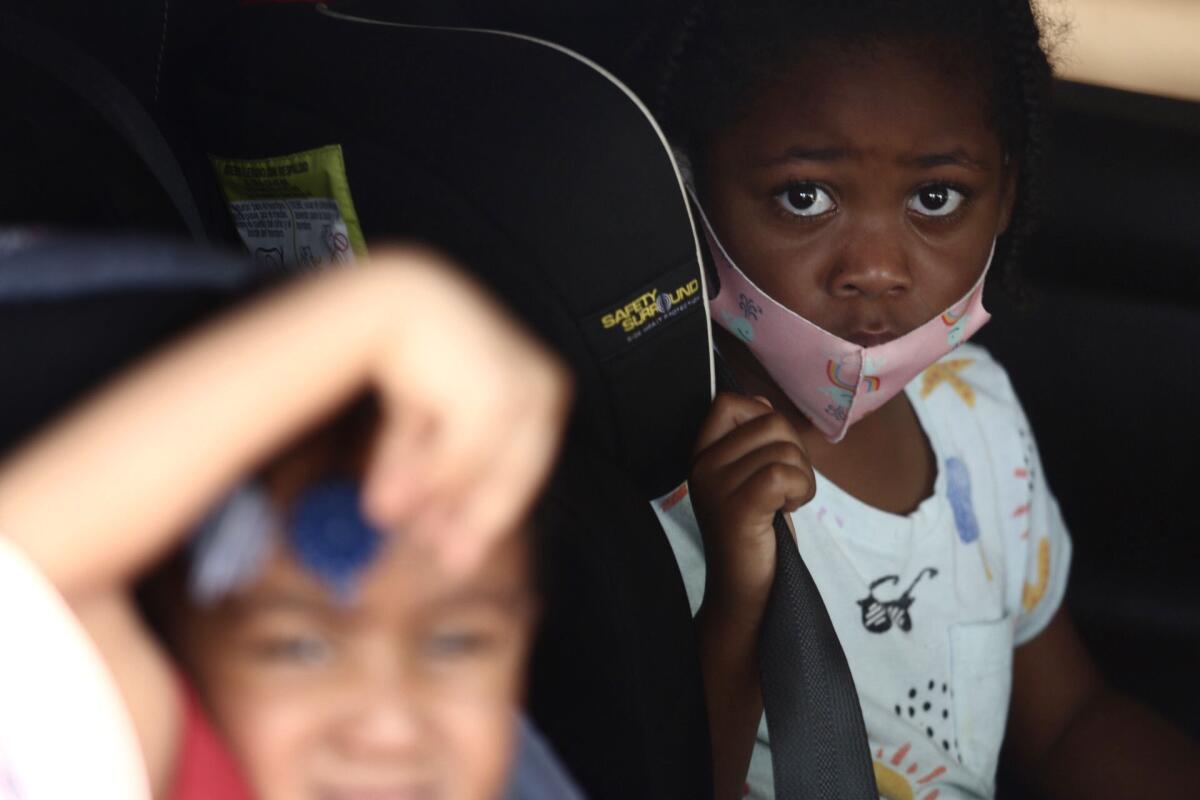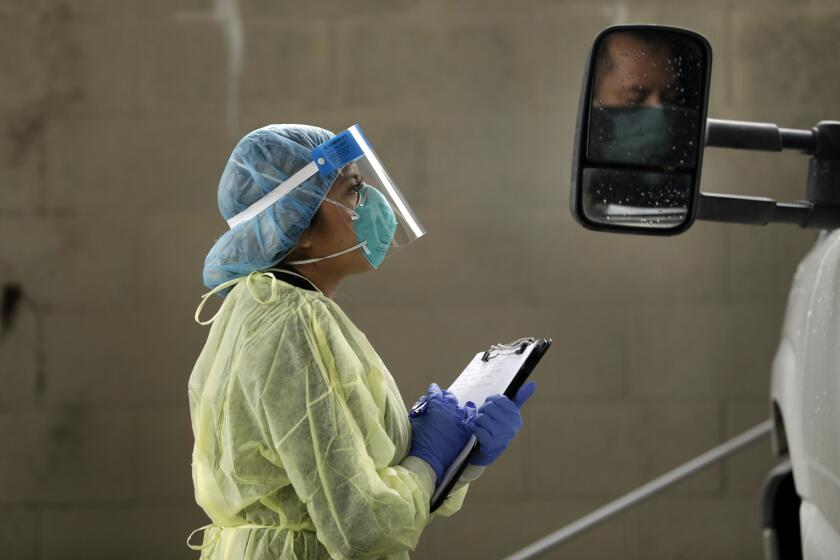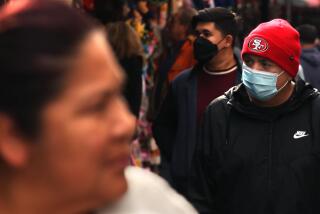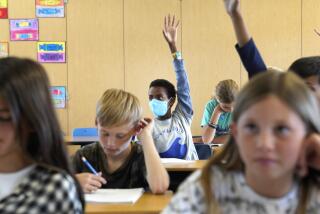California was impatient. Now it tops New York for most coronavirus cases

- Share via
California recorded some of the first COVID-19 cases in America and the country’s first known death, in what would become a worldwide pandemic. It responded with the nation’s initial stay-at-home order. Now, the Golden State claims another dubious distinction: more confirmed coronavirus cases than any other state.
California passed New York for that record Wednesday morning, reaching more than 409,000 cases and eclipsing New York’s 408,886, according to the Coronavirus Resource Center at Johns Hopkins University.
California is No. 1 in part because it is the most populous state but also because millions of residents have been unwilling, or unable, to practice the social distancing and mask-wearing that public health experts say are the best measures to keep SARS-CoV-2 somewhat in check.
“I think we started to exit shelter-in-place sometime around Memorial Day both emotionally and physically. And we are paying the price for that,” said Nicholas Jewell, a biostatistics authority at U.C. Berkeley. “It’s like we should be tip-toeing out on the ice. What we did, instead, was all run out on the ice, some not too cautiously. And a lot of people fell through the ice.”
It wasn’t so long ago that New York Gov. Andrew Cuomo was being pummeled for his state’s slow response to the pandemic, while California seemed to have dodged disaster with its early action.
But the tables have turned and the disease’s onward march here showed no sign of slowing Wednesday, as Gov. Gavin Newsom reported that 12,807 cases had been logged in the previous 24 hours. That marked a new record high for California and pushed the pandemic total to 413,576.
“It’s just another reminder,” Newsom said, “of the magnitude of impact that this virus continues to have.”
Though it passed New York in the total number afflicted, California (at nearly 40 million residents, more than double the population of the Empire State) has tallied just over 8,000 deaths from COVID-19, less than a third the death toll in New York.
The latest maps and charts on the spread of COVID-19 in California.
As in other states, some of California’s biggest outbreaks have been in elder care facilities, prisons and meatpacking plants. But the disease has spread to places without such confined spaces, such as Mono County, where restaurant workers have been among the most commonly afflicted.
New York City saw intensive-care wards overwhelmed and morgues deluged with bodies, as fatalities spiked at about 800 a day. Those scenes of suffering continue to epitomize the threat from the novel respiratory illness in America. Even with recent increases, California has not seen its intensive care system overwhelmed. The deadliest day for COVID-19 came on July 8, when 149 people died.
New York’s spring crisis should remain a cautionary tale for Californians, said Dr. Grant Colfax, director of public health for San Francisco. He said the emergency in New York revealed “how bad the pandemic can get and how rapidly it can get bad.” It should also put the Golden State on notice that even a sophisticated, well-financed healthcare system can become overwhelmed.
If the cases in the Bay Area continue to rise, “it is plausible we could get in the New York situation in the late summer or fall,” Colfax said.
But New York’s experience also confirms that upticks in COVID-19 can be reversed with a concerted public effort. “I just hope we can do that before a massive surge,” Colfax said. “New York unfortunately had to do that after a massive surge.”
New York’s pandemic storm appeared to come with one silver lining, compelling New Yorkers to “make a more dramatic and sustained change in behavior,” said Dr. Geoffrey Leung, ambulatory medical director of Riverside University Health System in the Inland Empire.
“In New York, everyone knew someone who had COVID,” Leung added, while many Californians still know of the disease only secondhand and thus lack “the emotional driver they had in New York.”
Leung said the Riverside health system has had to expand its intensive care capacity from 36 to 54 beds because of the influx of patients. Physical space is easier to provide than the emotional resilience of healthcare workers, several physicians said.
“The concrete that makes a hospital won’t wear down. But humans wear down,” said Dr. Armand Dorian, chief medical officer at USC Verdugo Hills Hospital. “My most difficult commodity to maintain is my front-line workers. How are we going to replenish these people or give them a break? That’s an issue we don’t discuss enough.”
Climbing hospitalization numbers represent one of the “downstream” impacts of increasing infections. They reached a new high this week — with 7,170 hospitalized statewide as of Tuesday. More than 2,000 of those patients occupied intensive care beds, according to the state Department of Public Health.
The death toll also continues to climb, with 674 fatalities for the week that ended Monday, the highest seven-day total to date. That number broke the record set in the previous week, when 640 died. The week before that, COVID-19 deaths numbered 474.
State officials sought to put the statistics in perspective.
“I don’t myself over-read into the significance of that number,” California Health and Human Services Secretary Dr. Mark Ghaly said Tuesday, when asked about California becoming No. 1 in total coronavirus infections.
He pointed to the state’s population and geographical size and added: “At the end, I really expect and hope that California is going to be the state that adapted the most, learned the most, prepared the best and that we are going to really reduce its impact.”
Newsom agreed that especially given the state’s size, even a slight increase in people having social contact would cause an uptick in the state’s numbers. Nonetheless, he called California’s case count “a sober reminder of why we are taking things as seriously as we are.”
California Gov. Gavin Newsom defended his reopening decisions and adopted the same argument made by many critics of his original order: The consequences of the COVID-19 shutdown for the economy and mental health were too great to ignore.
Hospitalization and death totals that are reaching new highs reflect exposure to the virus that occurred weeks ago, experts said. That becomes one of the key challenges in the fight against COVID-19: It can take weeks to see if steps taken to stem the spread of the disease are working.
Conversely, it can also take weeks to see the repercussions of not taking the contagion seriously, such as when people don’t wear masks around others, mix with people they don’t live with and decline to regularly wash and sanitize their hands.
Hospital administrator Dorian worries that a secondary kind of epidemic — a lack of public trust— is making it harder to gain broad public compliance. “It should be a simple notion, ‘Just wear a mask,’ but so often now I am confronted with people who say that is a political statement. It’s not.”
State health officials issued an order for those in public to wear a mask on June 18 and reimposed restrictions on many other activities last week. But Ghaly said it will take three to five weeks to determine whether those restrictions have cut infection rates. Jewell, the UC Berkeley epidemiologist, said restrictions on some travel would also help to slow the “mixing bowl” effect of coronavirus carriers spreading the virus around California and between states.
“We did well in March and April with some of the restrictions,” Jewell said. “But we got impatient. Now there is much more risk than there was back then, but it’s going to be much harder to get people back to following those rules.”
Times staff writers Maura Dolan, Iris Lee, Rong-Gong Lin II and Colleen Shalby contributed to this report.
More to Read
Sign up for Essential California
The most important California stories and recommendations in your inbox every morning.
You may occasionally receive promotional content from the Los Angeles Times.














